CHILD SAFETY AROUND DOGS
This is such an important subject and it is in the news too often, sadly with tragic events. Australian Cobberdogs are specifically bred to be the most gentle and kind companions and therapy dogs; loving and consistently non-aggressive .
However puppies and dogs, like all creatures, have no words to express their feelings or needs; they use body language and vocalising. But sometimes humans, especially little ones, cannot read the puppies body language or recognise what the puppy is trying to express. When hurt or threatened, or even when over-tired or wanting to be left alone, a puppy may feel a need to react to defend itself. It is very important to make sure both the puppy and children are safe and protected at all times.
These guidelines must be followed right from DAY 1 at home with your puppy and children, no excuses. This will help your puppy to grow up gentle, responsive and confident; and trustworthy around little people. Remember too that research suggests that children under 7 years cannot be totally responsible for puppy and dog care!
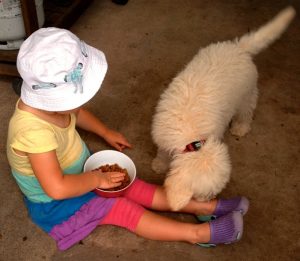
1 NEVER leave a very young child or baby alone
in the room or yard with a puppy or dog.
EVER.
2 Actively teach your young children
how to interact with your Cobberdog puppy. Your family is now the puppy's new pack, and it is important to teach your child how to gently reinforce the ‘order of the pack’ right from day 1. This sets the foundation for the rest of all the training, and confidence with child safety.
Please see our June Blog on this subject.
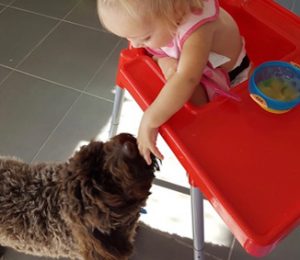
3 Supervise your child playing with the puppy.
Children cannot read puppy language or warning signs until they have been taught, so point out the puppy communication and warning signs as they occur. Help your child to recognise and read those signs and to respond appropriately.
The only way a puppy can communicate frustration is to growl or use its mouth. Baring teeth does NOT mean laughing or smiling, and tail between legs indicates fear/anxiety or aversion. Warnings can escalate to self-defence and hostility if not recognised and heeded.
Any of these signs means the child must stop and think what they are doing. Why did the puppy react? Was the child hurting or frightening the puppy? If so, teach the child that the puppy doesn't like that interaction and to change the play.
Sometimes, what the little puppy really needs is space or alone time until it is refreshed and ready to play again, a bit like the overtired toddler!
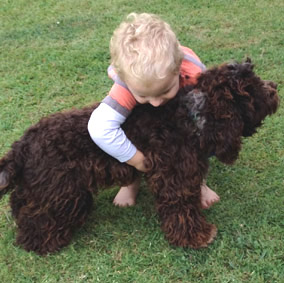
4 Always model kindness and caring
and teach the child to respect the puppy at every opportunity. When they respect the puppy, they will be mindful of how they treat the pup and how the puppy feels.
They must know never to sit on the puppy, pull ears, poke eyes or other irritating or harmful behaviours. Also teach the child to be careful when riding bikes or playing other rough games around the pup.
Remember too to teach your children patient, gentle discipline and positive reward for your puppy, instead of strong-handed or rough disipline. This will help the puppy learn with confidence and look for your positive guidance; great qualities for a gentle, calm and trustworthy dog!
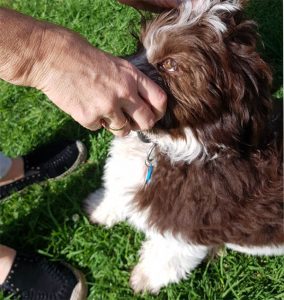
5 Teach the child safe, positive, interactions
with the puppy to keep their time together stimulating and safe.
Show them appropriate games to play with the pup, like tug-of-war, Kong toy with treats inside, chasing bubbles, sand pit, and so much more. Teach the child to train the pup in little tricks with rewards, like a small obstacle course, sitting, rollling, etc. Simple grooming like gentle brushing is a great bonding and productive activity!
6 Don’t disturb when sleeping or eating.
The puppy's crate area must always be the puppy’s safe, private retreat for resting and sleeping. The pup must be confident that he can escape to there at any time, to feel safe and secure if there is a need.
See our May Blog for more information about the importance of crate training.
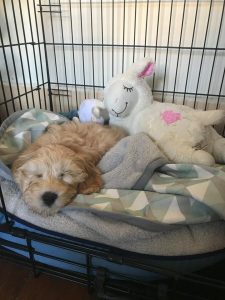
Last but definitely not least,
remember that not every dog behaves or is trained like your well-trained Cobberdog, so teach your children to NEVER just approach dogs they don’t know. That is another set of guidelines altogether!
